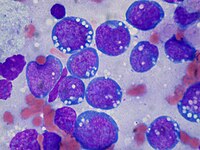
Photo from wikipedia
Background and Objective: Non-functioning pituitary neuroendocrine tumors (NF-PitNETs) represent a heterogeneous tumor type that lacks effective medical treatment. MDM2, the main negative regulator of p53, binds to and forms a… Click to show full abstract
Background and Objective: Non-functioning pituitary neuroendocrine tumors (NF-PitNETs) represent a heterogeneous tumor type that lacks effective medical treatment. MDM2, the main negative regulator of p53, binds to and forms a stable complex with p53 to regulate its activity. In this study, we measured the expression levels and role of MDM2 in non-functioning PitNET patients’ combined clinical features and investigated the effect of etoposide on the cell bioactivity of the GT1-1 cell line in vivo and in vitro. Methods: RT-PCR and immunochemistry measured the expression levels and role of MDM2 in 103 NF-PitNET patients’ combined clinical features. Cell proliferation, migration, colony and apoptosis experiments measured the effect of etoposide on the GT1-1 cell line in vivo and in vitro. Results: There was more invasive behavior (p = 0.013) in patients with high MDM2, who were also younger (p = 0.007), were more frequently female (p = 0.049) and had larger tumor sizes (p = 0.018) compared with patients with low MDM2. Patients with high p53 were younger (p = 0.017) and had larger tumor sizes (p = 0.034) compared with patients with low p53. Univariate (p = 0.018) and multivariate (p = 0.023) Cox regression analysis showed that MDM2 was the independent factor for invasive behavior in NF-PitNET patients. Log-rank analysis showed that the average progression-free survival (PFS) time in the low MDM2 patients was longer than that in the high MDM2 patients (p = 0.044). Functional studies indicated that etoposide inhibited cell proliferation and cell migration and induced apoptosis in p53 independence in GT1-1 cells. Furthermore, etoposide significantly inhibited the growth of GT1-1-xenograft in BALB/c nude mice. The tumor growth inhibition rate of etoposide was 67.4 ± 4.6% after 14 d of treatment, which suggested the anti-tumor activity of etoposide. Conclusions: MDM2 played the role of tumorigenesis of NF-PitNET in a p53 independence manner, and an MDM2 inhibitor could be a potential choice for the treatment of NF-PitNET patients.
Journal Title: Medicina
Year Published: 2023
Link to full text (if available)
Share on Social Media: Sign Up to like & get
recommendations!